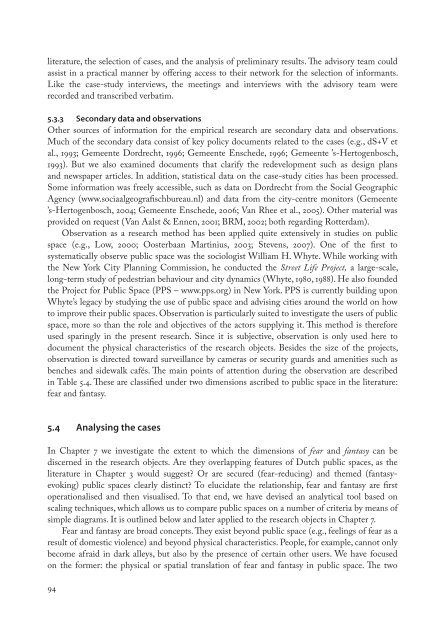Changing public space
Changing public space
Changing public space
Create successful ePaper yourself
Turn your PDF publications into a flip-book with our unique Google optimized e-Paper software.
literature, the selection of cases, and the analysis of preliminary results. The advisory team could<br />
assist in a practical manner by offering access to their network for the selection of informants.<br />
Like the case-study interviews, the meetings and interviews with the advisory team were<br />
recorded and transcribed verbatim.<br />
5.3.3 Secondary data and observations<br />
Other sources of information for the empirical research are secondary data and observations.<br />
Much of the secondary data consist of key policy documents related to the cases (e.g., dS+V et<br />
al., 1993; Gemeente Dordrecht, 1996; Gemeente Enschede, 1996; Gemeente ’s-Hertogenbosch,<br />
1993). But we also examined documents that clarify the redevelopment such as design plans<br />
and newspaper articles. In addition, statistical data on the case-study cities has been processed.<br />
Some information was freely accessible, such as data on Dordrecht from the Social Geographic<br />
Agency (www.sociaalgeografischbureau.nl) and data from the city-centre monitors (Gemeente<br />
’s-Hertogenbosch, 2004; Gemeente Enschede, 2006; Van Rhee et al., 2005). Other material was<br />
provided on request (Van Aalst & Ennen, 2001; BRM, 2002; both regarding Rotterdam).<br />
Observation as a research method has been applied quite extensively in studies on <strong>public</strong><br />
<strong>space</strong> (e.g., Low, 2000; Oosterbaan Martinius, 2003; Stevens, 2007). One of the first to<br />
systematically observe <strong>public</strong> <strong>space</strong> was the sociologist William H. Whyte. While working with<br />
the New York City Planning Commission, he conducted the Street Life Project, a large-scale,<br />
long-term study of pedestrian behaviour and city dynamics (Whyte, 1980, 1988). He also founded<br />
the Project for Public Space (PPS – www.pps.org) in New York. PPS is currently building upon<br />
Whyte’s legacy by studying the use of <strong>public</strong> <strong>space</strong> and advising cities around the world on how<br />
to improve their <strong>public</strong> <strong>space</strong>s. Observation is particularly suited to investigate the users of <strong>public</strong><br />
<strong>space</strong>, more so than the role and objectives of the actors supplying it. This method is therefore<br />
used sparingly in the present research. Since it is subjective, observation is only used here to<br />
document the physical characteristics of the research objects. Besides the size of the projects,<br />
observation is directed toward surveillance by cameras or security guards and amenities such as<br />
benches and sidewalk cafés. The main points of attention during the observation are described<br />
in Table 5.4. These are classified under two dimensions ascribed to <strong>public</strong> <strong>space</strong> in the literature:<br />
fear and fantasy.<br />
5.4 Analysing the cases<br />
In Chapter 7 we investigate the extent to which the dimensions of fear and fantasy can be<br />
discerned in the research objects. Are they overlapping features of Dutch <strong>public</strong> <strong>space</strong>s, as the<br />
literature in Chapter 3 would suggest? Or are secured (fear-reducing) and themed (fantasyevoking)<br />
<strong>public</strong> <strong>space</strong>s clearly distinct? To elucidate the relationship, fear and fantasy are first<br />
operationalised and then visualised. To that end, we have devised an analytical tool based on<br />
scaling techniques, which allows us to compare <strong>public</strong> <strong>space</strong>s on a number of criteria by means of<br />
simple diagrams. It is outlined below and later applied to the research objects in Chapter 7.<br />
Fear and fantasy are broad concepts. They exist beyond <strong>public</strong> <strong>space</strong> (e.g., feelings of fear as a<br />
result of domestic violence) and beyond physical characteristics. People, for example, cannot only<br />
become afraid in dark alleys, but also by the presence of certain other users. We have focused<br />
on the former: the physical or spatial translation of fear and fantasy in <strong>public</strong> <strong>space</strong>. The two<br />
94




